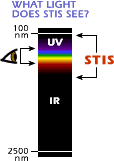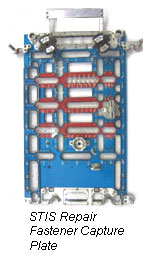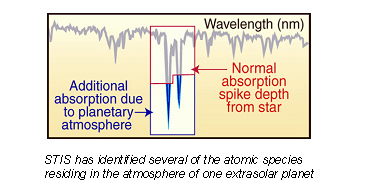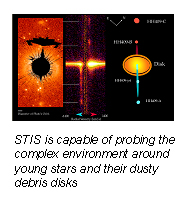 Overview
Overview
The Instrument
Scientific Future of STIS
Astronauts installed the Space Telescope Imaging Spectrograph (STIS) on the Hubble Space Telescope during Servicing Mission 2 in 1997. STIS stopped functioning in August of 2004 due to a power supply failure. It is currently in "safe mode" pending a repair attempt on Servicing Mission 4.
Instrument and Repair Overview
STIS is a highly versatile instrument with a proven track record. As the name implies, it can produce images,  but its main function is spectroscopy—the separation of light into its component colors (or wavelengths) to reveal information about the chemical content, temperature and motion of stars and gas. The instrument covers most of the ultraviolet bands, the entire optical wavelength band, and some wavelengths extending into the near-infrared. At the time when operations suspended in August of 2004, STIS science—dominated by spectroscopy—constituted about 30% of the Hubble observational program. This was an exceptional achievement on a telescope most known for its spectacular imaging. but its main function is spectroscopy—the separation of light into its component colors (or wavelengths) to reveal information about the chemical content, temperature and motion of stars and gas. The instrument covers most of the ultraviolet bands, the entire optical wavelength band, and some wavelengths extending into the near-infrared. At the time when operations suspended in August of 2004, STIS science—dominated by spectroscopy—constituted about 30% of the Hubble observational program. This was an exceptional achievement on a telescope most known for its spectacular imaging.
To repair STIS, astronauts will perform a spacewalk or Extra Vehicle Activity (EVA) to replace a low voltage power supply board that contains a failed power converter. The repair is straightforward but requires diligence, and Hubble engineers have designed special tools for the job. If successful, the repair effort will restore one of two fully redundant electronic chains (or "sides") of the instrument. Both were unusable after August 2004.
To begin the repair, the astronauts will install a new EVA tool, the "fastener capture plate", over the top of a STIS electronics access panel.  The capture plate will ensure that the 111 small fasteners (screws) that attach the panel to STIS are captured without astronauts having to grasp and stash them with gloved hands. The spacewalkers then will use a power tool to remove the fasteners. After detaching the panel (with the capture plate and fasteners attached), the astronauts will remove the failed power supply card and click in the new one, much like replacing a circuit board on a computer. A new, simplified panel will then be installed over the open electronics cavity—only this time the 111 fasteners will not be required. By throwing just two lever-like latches, the astronauts will lock the new panel securely into place. The capture plate will ensure that the 111 small fasteners (screws) that attach the panel to STIS are captured without astronauts having to grasp and stash them with gloved hands. The spacewalkers then will use a power tool to remove the fasteners. After detaching the panel (with the capture plate and fasteners attached), the astronauts will remove the failed power supply card and click in the new one, much like replacing a circuit board on a computer. A new, simplified panel will then be installed over the open electronics cavity—only this time the 111 fasteners will not be required. By throwing just two lever-like latches, the astronauts will lock the new panel securely into place.
For more detail on the STIS repair effort, visit the STIS website.
+ Back to Top
The Instrument
STIS has three detectors, each with 1024 x 1024 pixels. One detector is a charge coupled device (CCD) for detecting optical and near-infrared light, and the other two are Multi-Anode Microchannel Plate Array (MAMA) detectors for detecting near- (lower energy) and far- (higher energy) ultraviolet light. A limited filter set supports imaging, but STIS's forte is spectroscopy, the enabling component of which is a diverse set of gratings ahead of the detectors in the optical chain.
Gratings, like the more familiar prisms, create a spectrum by separating light into its individual wavelength components. Close examination of the amount of light at each wavelength reveals the presence of absorption and emission lines, which are the "fingerprints" of the chemical composition and physical and dynamical states of stars and gas.
The astronomer has a wide choice of gratings according to her or his needs for wavelength coverage and spectral resolution.
A unique feature of STIS is that by having light enter a long, narrow slit before reaching the gratings, a separate spectrum can be recorded simultaneously along each of the 1024 "pixel rows" of the detector. One speaks of "multiplexing," "spectral-spatial mapping," and "2-D spectroscopy" when talking about this highly efficient and unique aspect of STIS. This capability is complementary to COS, which is designed for the easy grasp of exceedingly faint levels of light in the far-UV. Working side by side, each instrument will partly back up the other, with each offering something the other does not. Together, the COS-STIS team will offer a full set of spectroscopic tools for Hubble astronomers.
+ Back to Top
Scientific Future of STIS
Although it performed brilliantly for 7.5 years before suspending operations in 2004, the promise and potential of STIS are far from exhausted. Some glimpses into STIS's scientific past offer a taste of future endeavors:
Black Holes –  The light emitted by stars and gas orbiting around a black hole appears redder when moving away from us (redshift), and bluer when coming toward us (blueshift). By looking for this telltale Doppler shift, STIS has uncovered and weighed several dozen supermassive black holes at the cores of galaxies, but there is still much work to be done. To nail down the relationship between black hole mass and the properties of the host galaxies, more observations of both high- and low-mass black holes are needed. The light emitted by stars and gas orbiting around a black hole appears redder when moving away from us (redshift), and bluer when coming toward us (blueshift). By looking for this telltale Doppler shift, STIS has uncovered and weighed several dozen supermassive black holes at the cores of galaxies, but there is still much work to be done. To nail down the relationship between black hole mass and the properties of the host galaxies, more observations of both high- and low-mass black holes are needed.
Galaxies – STIS can simultaneously record the spectra of up to 1024 spatially distinct locations within an extended object such as a galaxy.  This is a crucial tool for the efficient mapping of a complex environment. As an example, long-slit STIS spectra of young star clusters in the merging "Antennae Galaxies" revealed their ages, chemical compositions and velocities, and the slit was crucial for subtraction of the "sky background." More STIS observations such merging galaxies are important to our understanding of these complex systems. This is a crucial tool for the efficient mapping of a complex environment. As an example, long-slit STIS spectra of young star clusters in the merging "Antennae Galaxies" revealed their ages, chemical compositions and velocities, and the slit was crucial for subtraction of the "sky background." More STIS observations such merging galaxies are important to our understanding of these complex systems.
Planets and Stars – STIS spectra of the transiting star-planet system HD209458 resulted  in transit light curves so precise that starlight absorption by the planet's atmosphere was detected, allowing the identification of several planetary atmospheric constituents-a first. More examples of bright transiting systems are now known and available for study with a repaired STIS, and the promise of yet more systems being discovered is high. STIS was used to map the dust and gas around the famous star Eta Carina and to understand the chemical content of various classes of stars. in transit light curves so precise that starlight absorption by the planet's atmosphere was detected, allowing the identification of several planetary atmospheric constituents-a first. More examples of bright transiting systems are now known and available for study with a repaired STIS, and the promise of yet more systems being discovered is high. STIS was used to map the dust and gas around the famous star Eta Carina and to understand the chemical content of various classes of stars.
+ Back to Top |